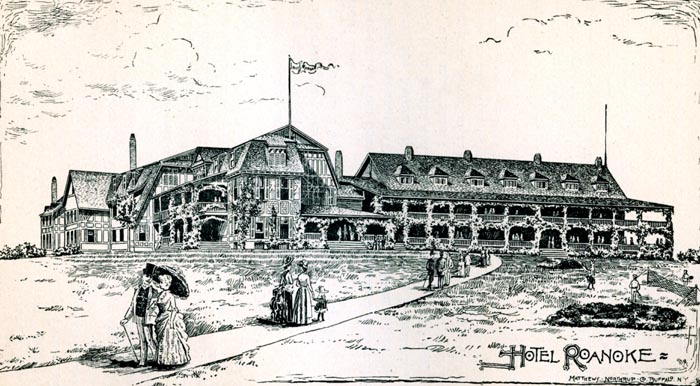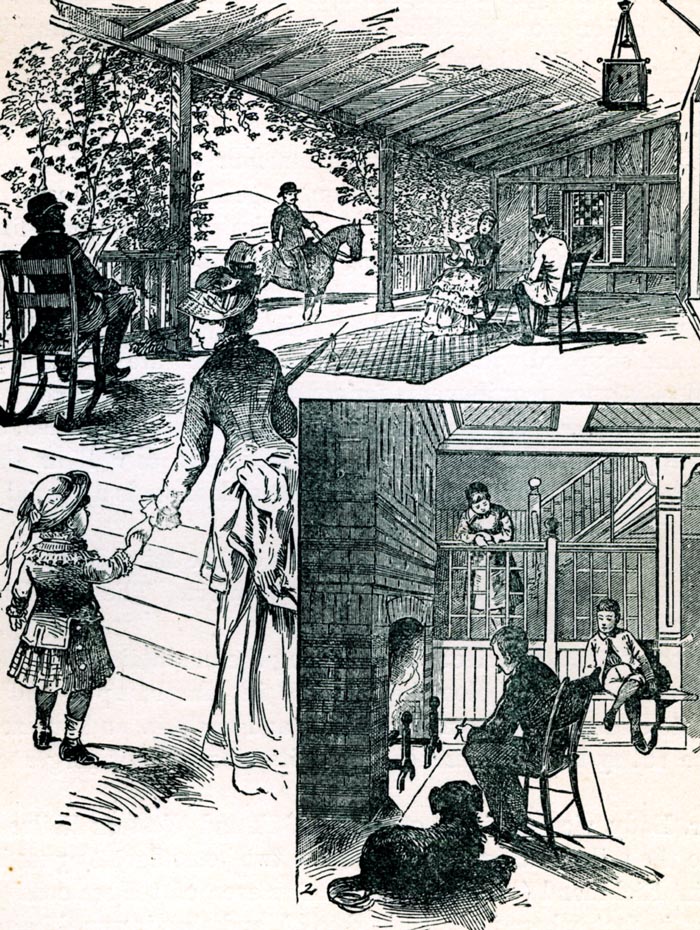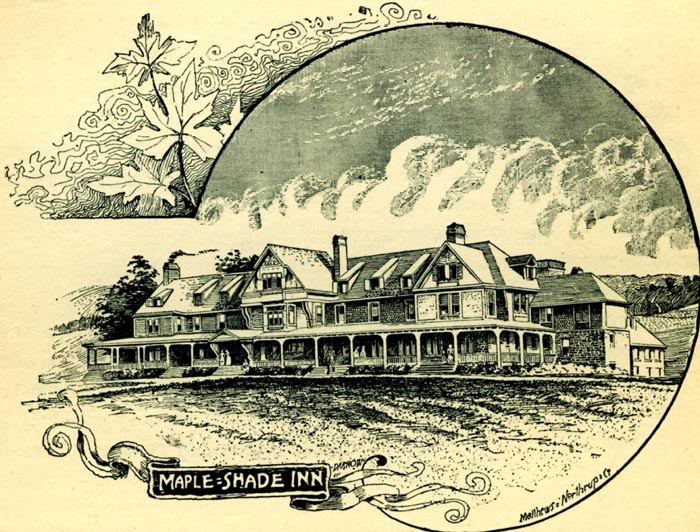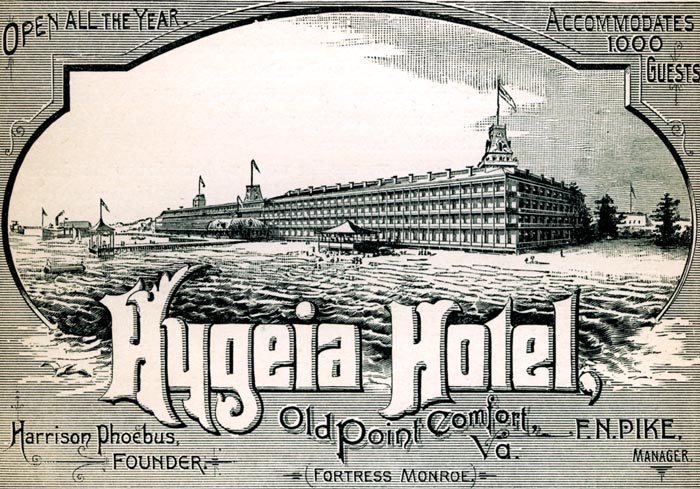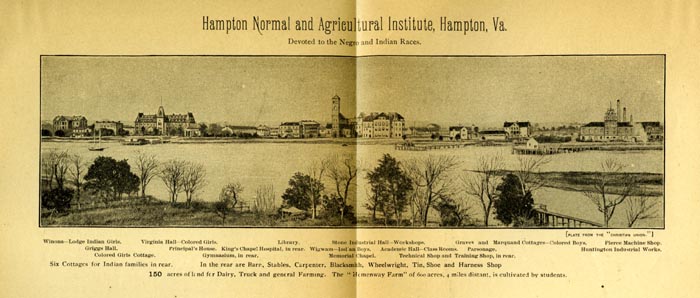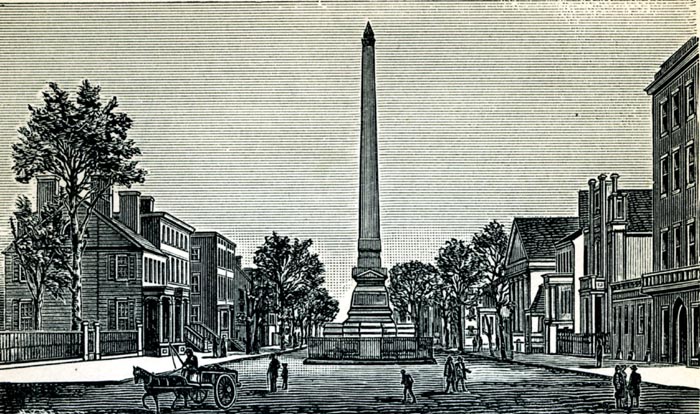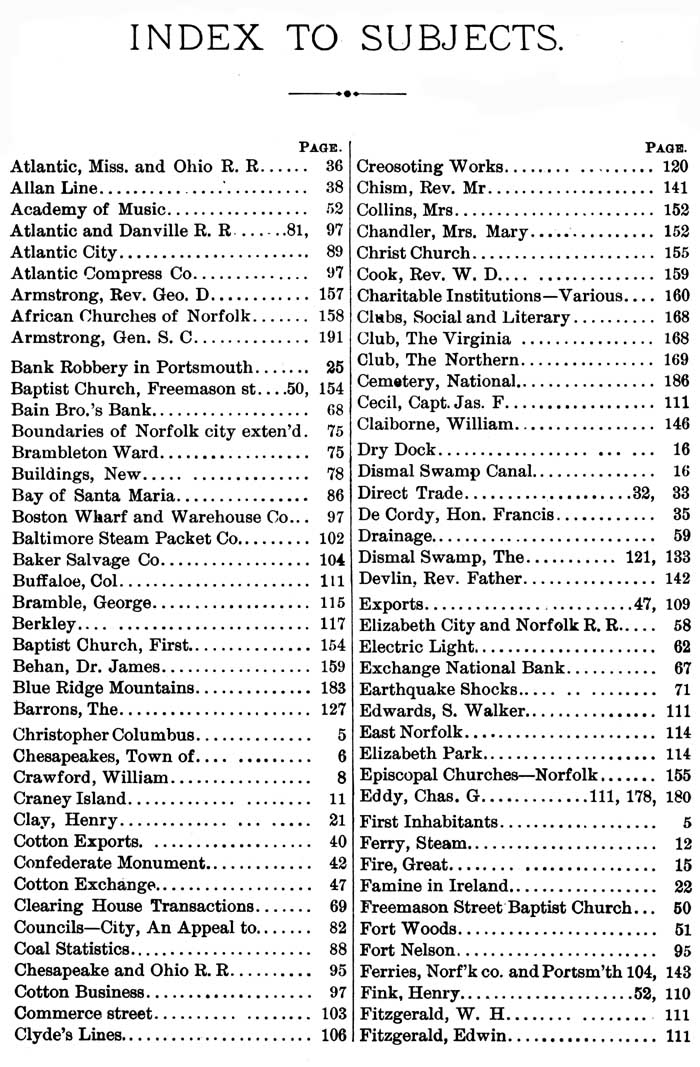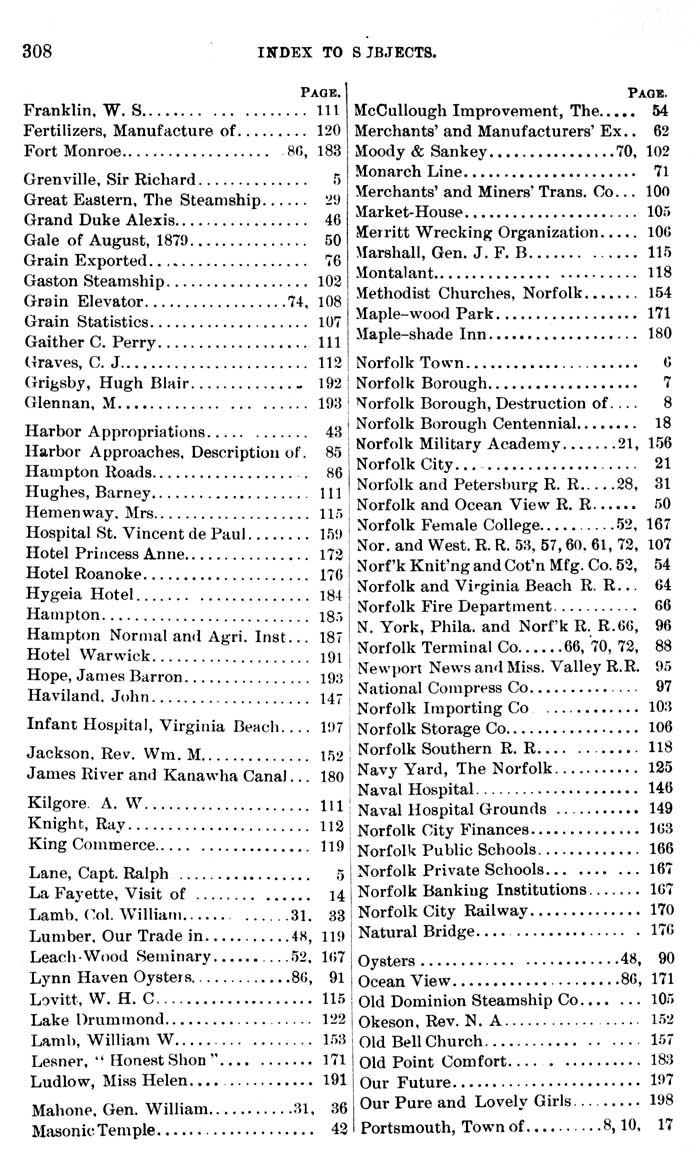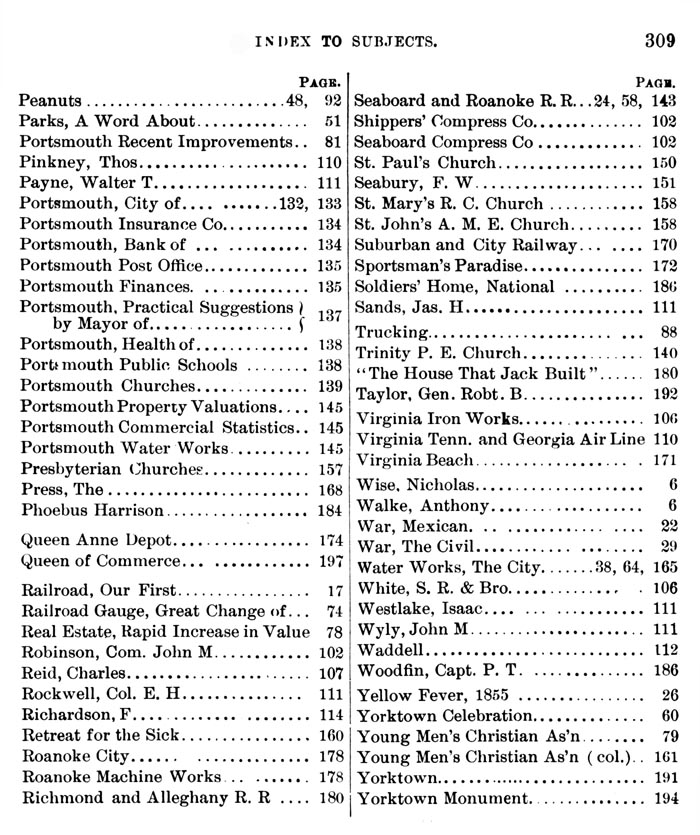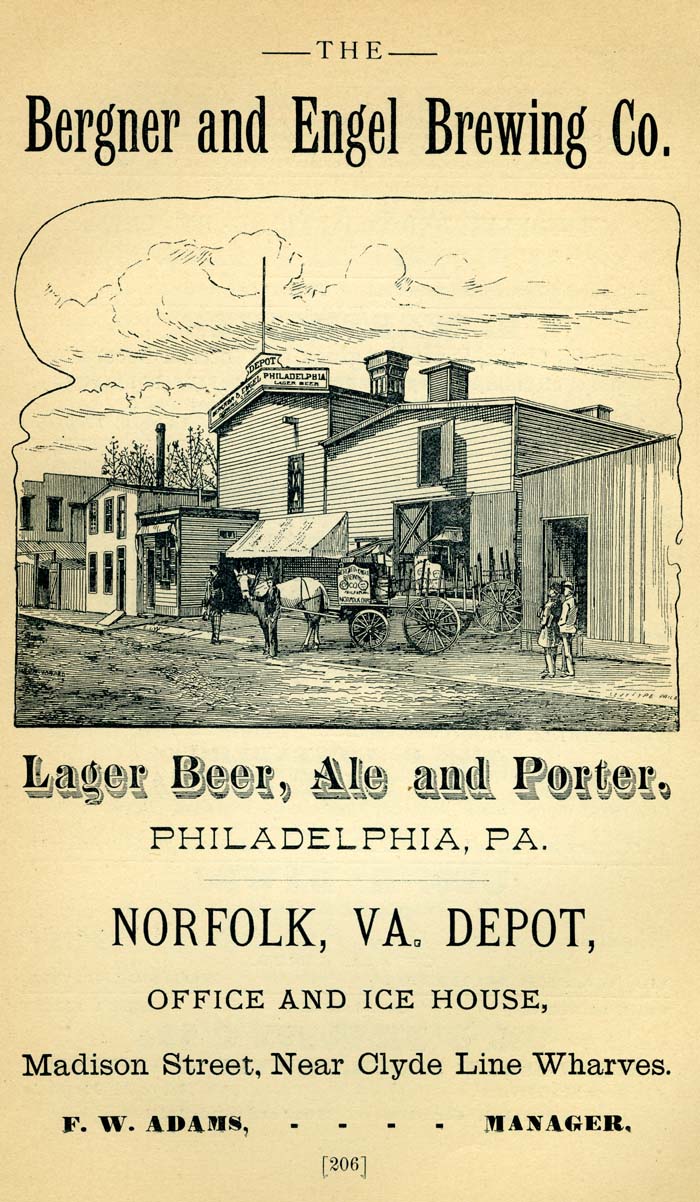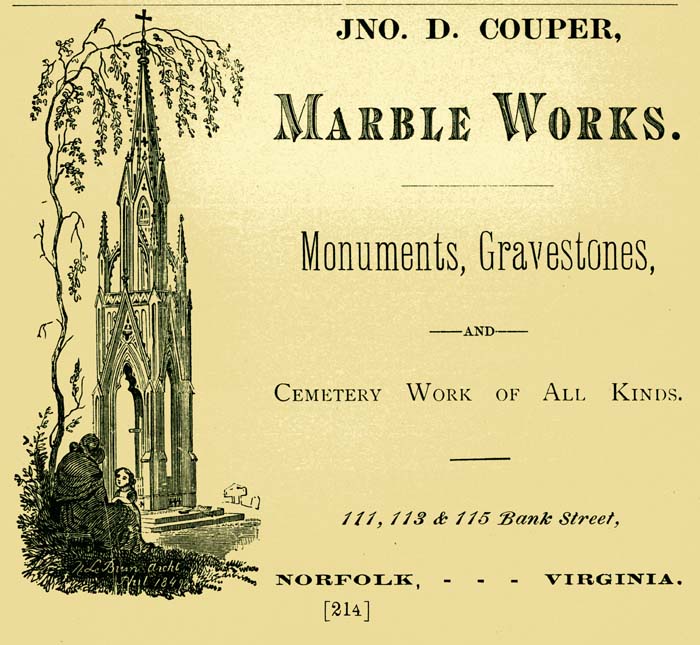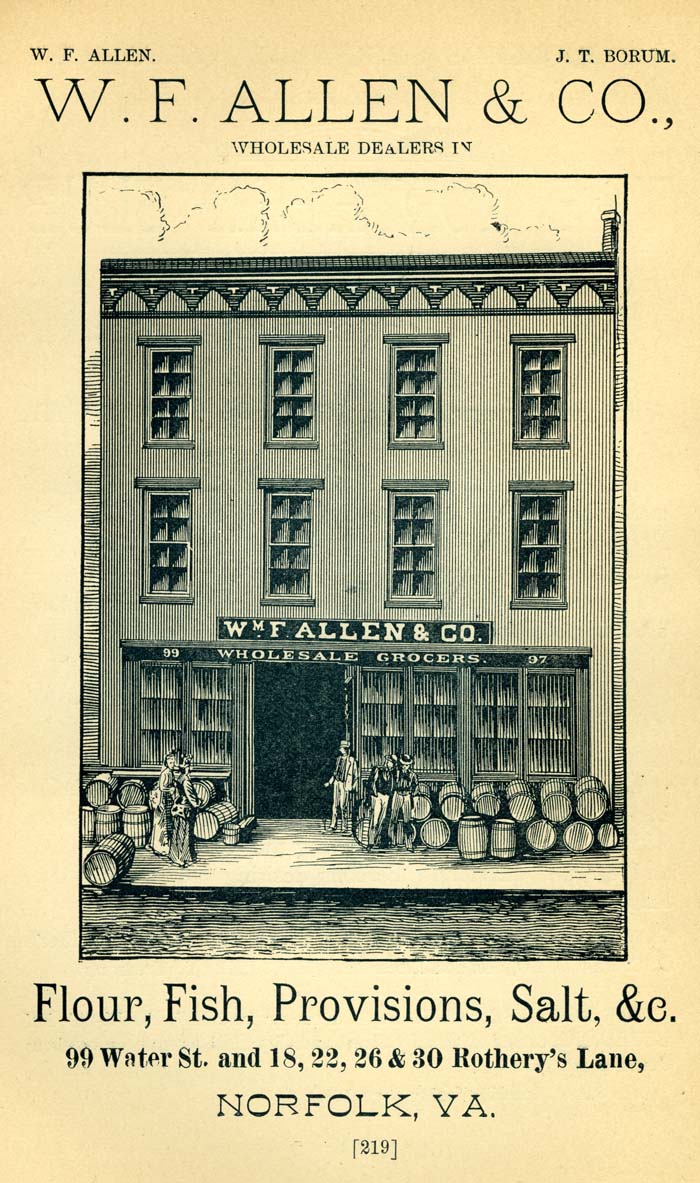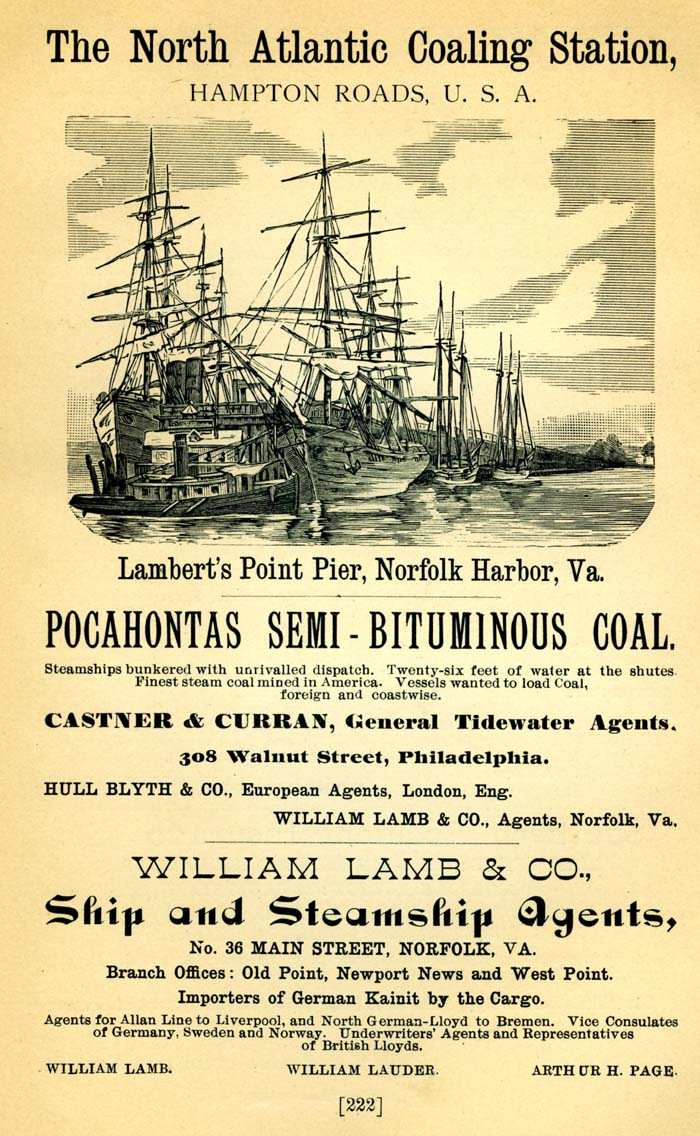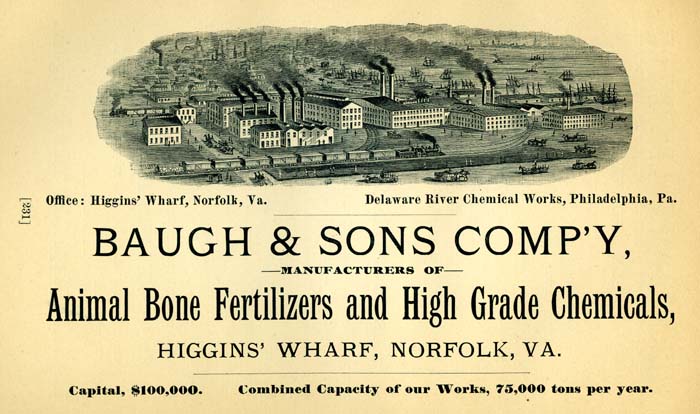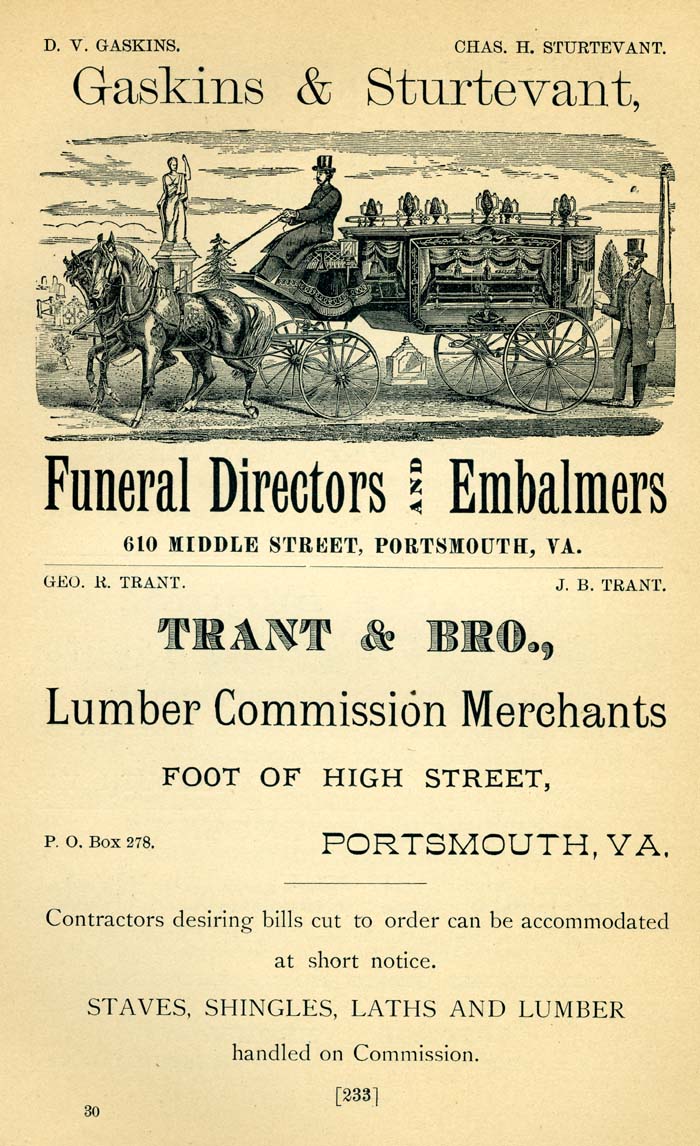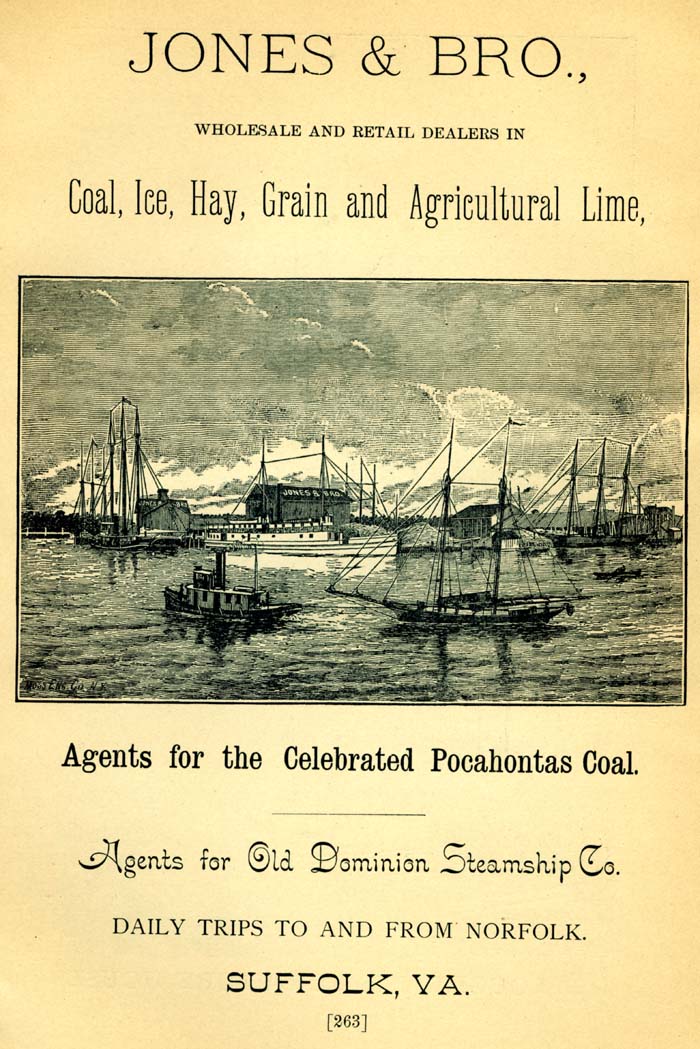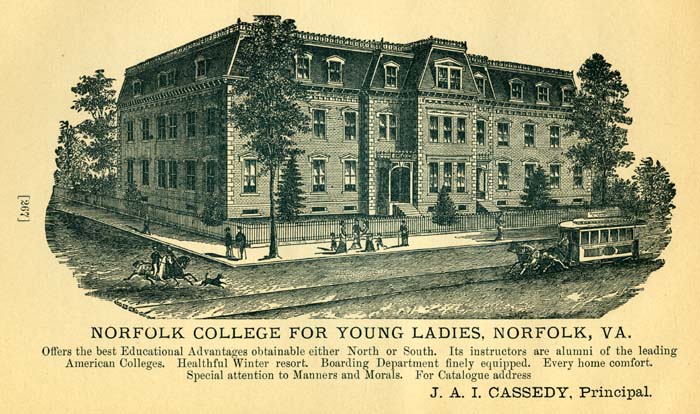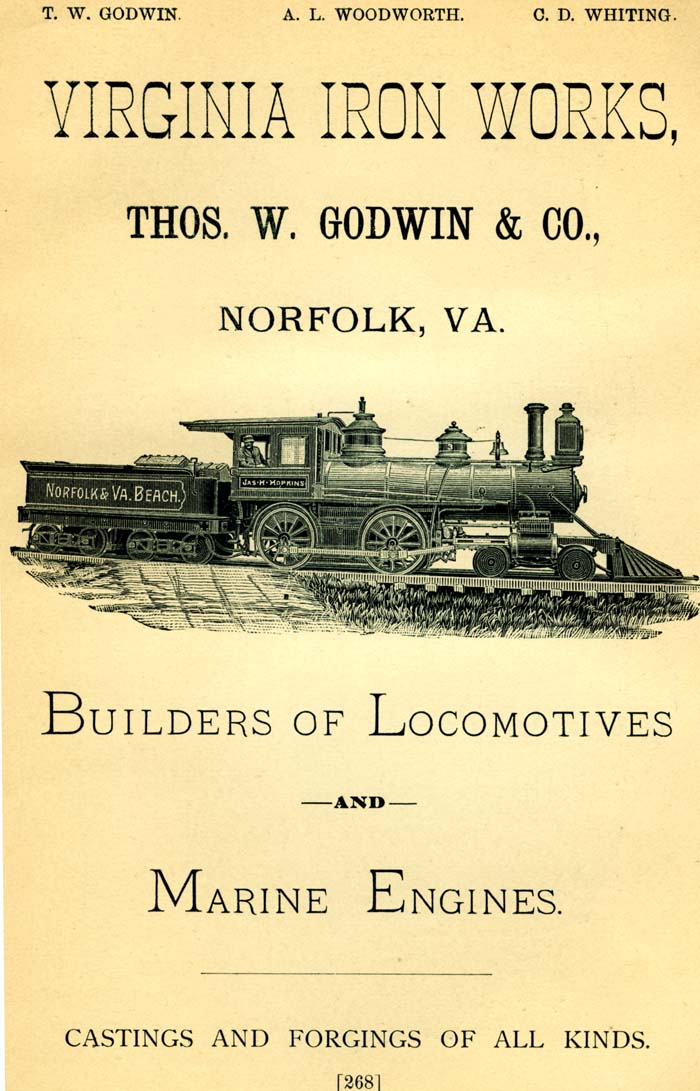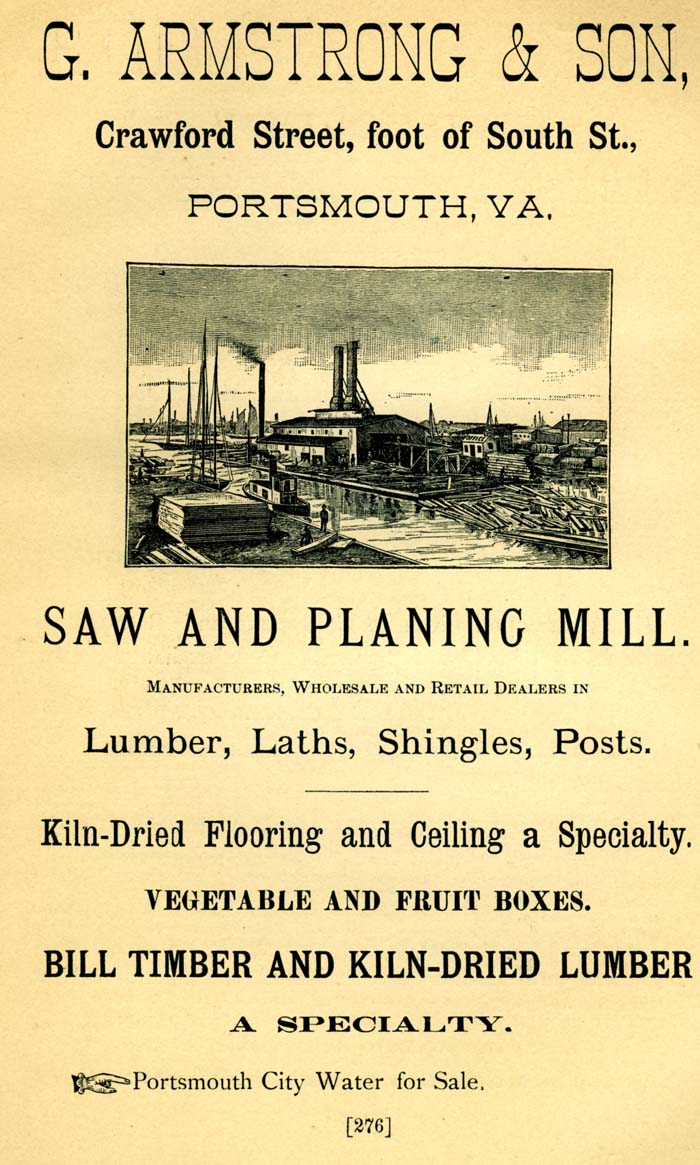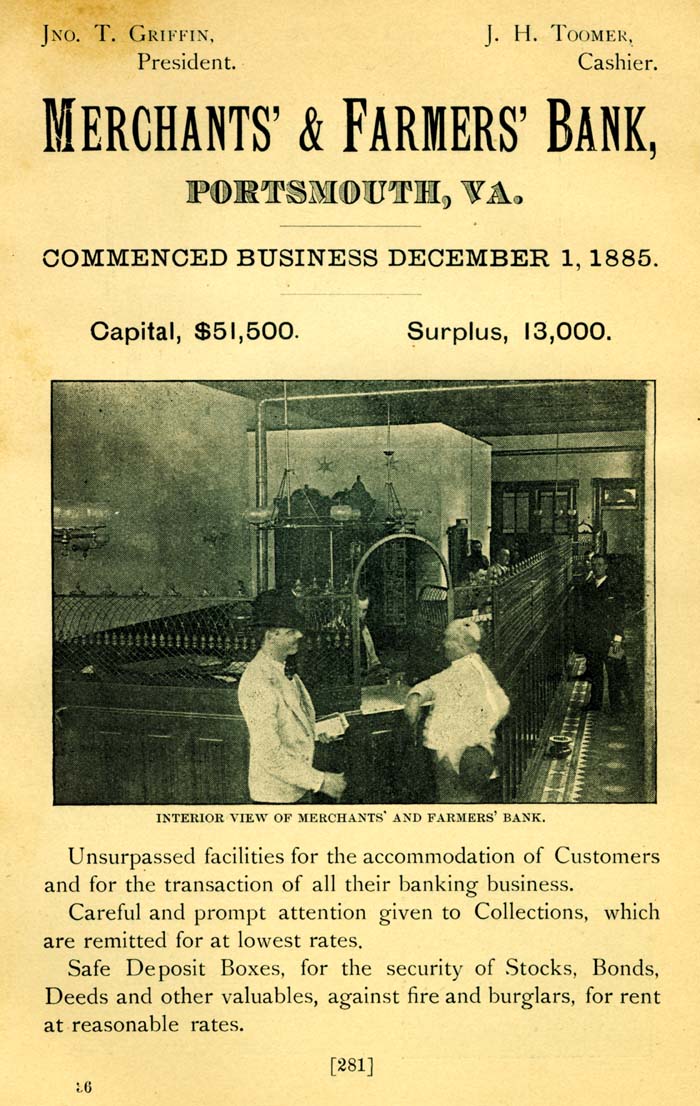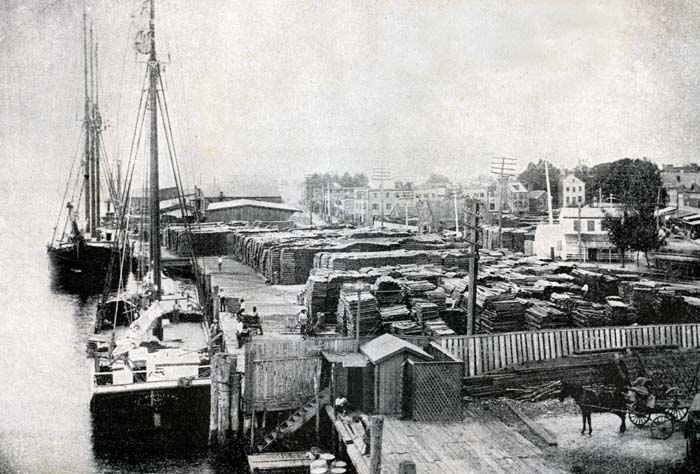OUR TWIN CITIES
OF THE NINETEENTH CENTURY:
NORFOLK AND PORTSMOUTH
THEIR PAST, PRESENT AND FUTURE.
Robert W. Lamb, Editor.
Norfolk, VA: Barcroft, Publisher.
1887-8.
Norfolk Landmark Steam Presses.Reproduced by Donna Bluemink.
Continuation.
CHAPTER VIII.
Pleasant Neighbors on Mountain Slope and Seashore and Our Future Prospects.AFTER spending a night on the beautiful Virginia Beach and feeling thoroughly invigorated by its life- and health-giving air, and somewhat appeased an appetite—of which we are almost ashamed —by an early breakfast, we have taken the early train, reaching Norfolk just in season to step over to the handsome passenger depot of the Norfolk and Western Railroad, built in the Queen Anne style, as shown in the accompanying illustration; and we are soon seated in the 8 a. m. train with a
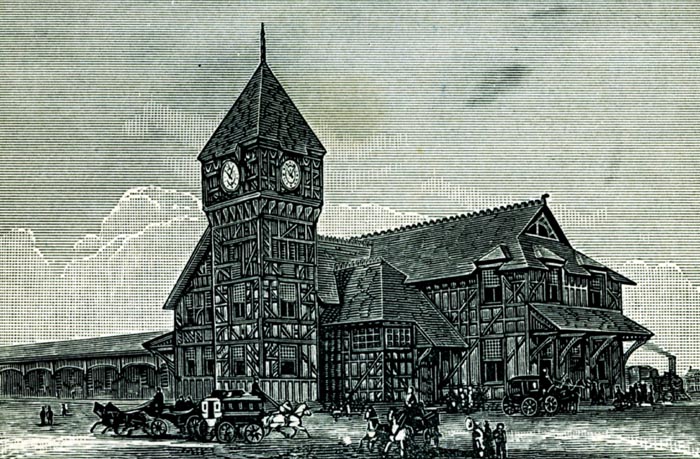
Norfolk and Western Railroad Depot.
friend from the mountains, ready to run up the road to convince him how really near he and his friends are to Norfolk and how identical, therefore, our interests should be. To think we have had a dip in the sea and a breakfast to the sound of Old Ocean's roar! Then, hurrying on, we reach the Hill City in time to dine, and still onward, scarcely halting as Liberty and the bold peaks of Otter are passed, and somewhat tired but ready for supper, we arrive at that wonderful "mushroom" which the Norfolk and Western Railroad has raised on the site of old "Big Lick."
Here we climb the hill and are soon snugly quartered in the beautiful Hotel Roanoke which surmounts it. We leave by the Shenandoah Valley Railroad tomorrow for the Natural Bridge station, thence to that wonder [175] of the world that gives the station its name—the goal of every true Virginian and lover of our immortal Washington.
Let those who can by all means take this trip, coming up to Roanoke by the Norfolk and Western Railroad and viewing that wonderful town [176] and its hotel, which will well reward the curious. For those who are less fortunate than we are we present two views of it, and beg leave to eliminate from the "Through Virginia" of our Norfolk and Western Railroad friends the following lucid description:
"The three buildings which catch the eye of the traveler, and surprise him, are the railway station and its "low-ceiled, dainty" eating-house, in the Queen Anne style—though, as Charles Dudley Warner said of it, that queen probably never sat in so tasteful a dining-room or had so good a dinner; the railway headquarters, falling in a cataract of peaked roofs and balconied fronts down the slope of the street; and the splendid hotel crowning the hill in the midst of lawns, parterres of flowers and ceaseless fountains. In the presence of the accompanying illustration it would be superfluous to describe its outward appearance.
"Interiorily—to speak now of the Hotel Roanoke—the wood-work is hard pine, finished in the natural grain; the furniture ash and cherry, and all the arrangements are tasteful as well as commodious. The parlor is as pretty a room as you will find in many a mile, and the dining-room light and cheerful, with small tables and growing plants. * * There is not a better resting-place for the tourist than this."
We must again acknowledge our indebtedness to "Through Virginia" for the following grand description of that sublime spectacle the Natural Bridge, to which we have wended our way after a refreshing night's rest at the Hotel Roanoke:
"Forty-one miles from Roanoke, on the Shenandoah Valley Railroad, is Natural Bridge Station, two and one-half miles from one of the wonders of the world, the Natural Bridge. It approaches Niagara in grandeur, and exceeds it in height and in awful mystery. It is a single block of limestone, with many shades of color, wide enough to span Broadway, high enough to throw in shadow the turrets of Trinity Church. The walls are as if cut with chisels, and there is no sign of displacement. Under it 'men look like boys and trees like bushes.'
"The visitor follows a tumbling cascade down a deep fissure in the mountain, under some of the largest arbor vitæ trees in the world, and turning down a long line of steps cut in a precipice, without guide or direction, suddenly finds himself by a swift stream in a dark canon, and the great bridge far above him. He passes into the awful hush of its twilight, into the conscious presence of the Creator. Birds, high in air, pass under the blue arch; the place is full of echoes, and the wind and waters moan eternally.
"The story of its building has never been told. It is a mighty monolith. Its uniqueness adds to its interest. There are natural tunnels, and elsewhere fissures and streams are spanned with rock masses lodged in falling, and with a free imagination these may be called bridges; but there is no awful mystery; no harmony; no perfect proportion; no [177] natural relation of height of pier, and spring of arch, and depth of keystone, and width of way; no parapets; no twin buttresses; no unseamed walls; no painted pillars. We wonder if this was formed by a great convulsion, or by the slow wearing of waters, or the slower gnawing of gases. We only see that it has all the appearance of infinite design; all the perfection of plan and purpose."
HOTEL ROANOKE. J. Porch. 2. Main Stairway.We present our readers with a handsome illustration of this wonderful freak (?) or work of nature, but we advise a visit and a sojourn at the charming hotel, if possible, and as long as practicable.
The Natural Bridge forest is a great elevated park 1,500 feet above sea level. It includes the wonderful Bridge, the Glen, and five round-topped mountains—Jefferson, Mass Hill, Lebanon, Lincoln Heights and Cave [178] Mountain. Ten miles of carriage-roads and bridle-paths lead over these summits and through great arches. The park itself abounds with objects of interest, while around it are rich green valleys, and beyond, the beautiful Blue Ridge, notably the overlooking peaks of Otter. The glint of granite marks where the James River has broken its way through.
The path that follows Arbor Vitæ Falls—sometimes a stone stairway, then a ledge along the precipice—leads through "the beautiful arch with the blue skies over it and the blue skies under it," past the Giants' Stairway and the Profile (the fairest face ever yet graven on the mountain), into a wild canon more beautiful than Watkins Glen, extending to Lace-water Falls, two miles above.
Here we will find cascades and overhanging crags, precipices based with ferns and broidered with lichens, moss-covered rocks and giant trees, and a stillness unbroken save by the murmur of waters or the song of birds—in a word, a place for meditation, forgetfulness and rest.
Here, too, of late has been erected a series of exceedingly fine hotel buildings, the Natural Bridge Inns, in perfect keeping with the natural surroundings, which have been tastefully and judiciously touched up by the fingers of Art, so far as could be consistently done with a due regard to effect, and supplied with all the properties which are needed to gratify taste and satisfy the requirements for comfort in a modern hotel.
They are commodious, comfortable and handsomely furnished, and the table is supplied and served with all the delicacies as well as the solid attractions of a real country home. For the sick there is a special cuisine and the services of a trained nurse.
At this charming resort the spring opens on the 1st of March, the latitude being the same as that of Old Point Comfort. The pine forests are as sweet-scented as any in Georgia.Here, too, we find a perfect shelter among the mountains from the harsh winds of the North, and blooming flowers in March, April and May, a dry climate entirely free from mosquitoes and malaria, and an exemption from the sultry heat of summer amidst its breeze-swept gorges and cool retreats.
As Mr. Eddy, vice-president of the Norfolk and Western Railroad, suggested to the railroad commissioners some two years ago, August is a hot month in Richmond (and we must confess even on the sea coast at midday—but, in fact, where isn't it hot then?), and that it would be pleasant to take a trip over the line of his road and see what was doing in Roanoke. This we have an opportunity to do in returning from the Natural Bridge, and we are sure that a visit to the machine works and the beautiful surroundings will prove very interesting and agreeable to one—even though he is not an official.
We are forcibly struck by the rapid industrial and commercial progress of this new city of Roanoke, which we have incidentally styled "a mush- [179] room," but perhaps in doing so have done unintentional injustice to a growth which really seems to be as substantial as it has been phenomenal. The immense iron and coal deposits of the section in its neighborhood have attracted the attention of iron-workers both in this country and Europe with very apparent results.
The demands of public opinion for an increase of our navy and a more efficient defense of our sea and lake coasts have caused the Government to look around for a suitable place for locating a plant for the manufacture of heavy guns. With this object in view, a committee of naval officers visited the city of Roanoke in May, 1888, and, after inspecting the machine plants in operation, took a tour of observation up the Cripple Creek extension of the N. and W. railroad through the iron regions, and also on the New River division to inspect the coal mines at Pocahontas.
This plant if made at Roanoke would give employment to 3,000 men and doubtless largely increase the population of that city.
It is perhaps a significant fact, as showing our interest in the matter, that the N. and W. Railroad officials, who had captured the visiting party at Roanoke, were not satisfied until they had brought them over their road to Norfolk and fully exhibited all the advantages and improvements of our magnificent harbor.
Extending our tour westward we have the opportunity of taking the New River division, by which from Pembroke station we reach Bald Knob and Mountain Lake, two familiar spots to many from our sister cities; or still onward to Pocahontas, so near to us through its daily supply of "black diamonds." If time is wanting for the New River trip, [180] or on our return, we proceed up the road to Pulaski, and here we rest at the beautiful Maple-shade Inn, which, Mr. Eddy says, is the finest hotel in Virginia—and he ought to know. We present its exterior, gentle reader, for your consideration, but must leave the decision of its interior qualities to your good judgment when the opportunity to visit it occurs.
Without stopping for the run up the Cripple Creek branch, which is soon to pour the wealth of iron from that replete region down into our port, we must hasten back for a reviving sniff of the salt sea air and a sight of our natural advantages. Our southwestern friend suggested in parting that we certainly had two "natural advantages" in Norfolk that he didn't think could be surpassed—soft crabs fresh from Lake Mahone, and brandy juleps from the veritable Jack Franklin—him of "the house that Jack built." As we are honestly and practically teetotallers, we had, of course, to dissent from this latter commendation of our friend.
Apropos of the Natural Bridge, we are reminded by a very enthusiastic young friend, but recently returned from that famous locality, that there is another and most charming route by which it can be reached—and as he has given it a personal inspection, he speaks by the card.
Taking the "Richmond" car on the N. and W. railroad—the only all-rail route, by the way, to the State Capital—we reach that city in about four hours, have a chance to spend the day if desired, or at any rate to take a good night's rest and breakfast at a reasonable hour, before leaving in one of the comfortable coaches of the Richmond and Alleghany railroad for a ride of 178 miles to Natural Bridge station.
The mention of this road naturally recalls a great venture of our past, familiar to those who lived some half-century or even perhaps a score of years ago—the James River and Kanawha Canal.
It was a favorite scheme or dream of our forefathers even in the old Washingtonian or Jeffersonian days, to open a grand waterway through the old Commonwealth from the Ohio to the headwaters of the James.
Those old-time Virginians were no doubt intellectually giants; they were in truth most elegant gentlemen, and hospitality reigned almost to a fault—and as talkers, their eloquence was unrivaled; but somehow when it came to practical works that were to develop our resources, something was wanting, capital or energy, and that "born-tired" feeling seemed to take possession of them, so that our grand old mother—"God bless her"— got to be a laggard instead of keeping abreast of the times, and has been caught and passed by those who were far her inferiors in natural advantages.
The James River and Kanawha Canal was to have been our "Erie," but the DeWitt Clinton was wanting to bring this grand hope to a complete fulfillment. The company was incorporated in March, 1832, and the canal commenced in 1836, and was actually dug from Richmond to Buchanan, at a cost of over $10,000,000, a distance of 197 miles, leaving 203 [181] miles before reaching completion. We will still linger in the past long enough to give, in the language of an able writer of thirty-five years ago, what was the expected future of our harbor in the event of the completion of this great work: "The James River and Kanawha Canal will afford a Southern water-line of transportation for the heavy products of the West, which must be for a long period of the year without a competitor, owing to the ice in the waters north of it. Such articles of commerce as would pass upon a canal in preference to a railroad would prefer this, for the reason that it would lead to the nearest Atlantic harbor, and consequently the cost upon it would be the least for internal or domestic transportation. A canalboat at Columbus, Ohio, laden with pork, hemp, tobacco or corn, would greatly prefer going to Norfolk upon this canal to passing through the lakes and the Erie canal to New York, if the market was as good at one place as the other, for the simple reason that the distance would be greatly shorter and the navigation much safer from interruption by ice and from the dangers of the lake. The market would be as good at Norfolk as New York, because the trade would be intended for foreign nations, and of course the foreign price would regulate that at the port at which it would be purchased for transportation."
And again: "When Virginia's great Central canal shall have been completed, and she shall have reclaimed all the solid charms of the 'River of Beauty,' Norfolk will spring up into the New York of the South."
The very able report of the late eminent scholar M. F. Maury, of Virginia, on the geographical position, commercial advantages and national importance of our State, made early in 1869, with its powerful arguments in favor of the completion of this great waterway, is familiar to every reader, in and out of the Commonwealth, who was at all interested at or about that period in the development of our State. Starting out with the intention of a mere friendly mention of a pleasant neighbor, the N. and W. Railroad, we have been led into this review of its predecessor that we may note how experience has taught us that the march of progress often sweeps away the best-laid schemes and most elaborate theories of our ablest thinkers. A decade from the issue of Maury's able report, and the work of a half-century was practically swept away by the charter of the R. and A. Railroad in 1879, by which that road acquired the property, works and franchises of the James River and Kanawha Canal Co. and the Buchanan and Clifton Forge Railway Co., and was opened to travel, through the bed of the grand old waterway, in the fall of 1881. It is not our intention to follow this road through its struggles and trials, nor comment upon its apparent want of success as a pecuniary venture in the past, nor anticipate the merited success which probably awaits it in the future development of our great Commonwealth and that rich and varied section through which it passes. We may say incidentally, however, that the story of our harbor and its progress as already told by us certainly [182] demonstrates in a measure at least the truth of the theory of the able writer from whom we quoted in regard to our future, though the development has come and will still come, we think, through our rail and not water connections; and the physical connection of the R. and A. railroad at Lynchburg with the N. and W. railroad would open a new avenue of trade that would no doubt lead to a more rapid progress of our sister cities towards commercial greatness.
But we must turn from the consideration of these weighty subjects to that of a pleasant way of travel for recreation, to which our young friend asserts this road has paramount claims, for he says, and no doubt truthfully: "For convenience of business centres, suitable schedule of trains, attractive scenery, comfortable coaches, and rock-ballasted roadway, the R. and A. railroad, passing its entire length through the fertile and beautiful James River Valley, offers the largest number of and most attractive summer homes, in the large, roomy and convenient mansions on the banks of the James, with every comfort of extensive and shady lawns, orchards, and gardens, the pride of former wealthy planters, whose owners now agree to take boarders for the summer months at reasonable and ofttimes exceedingly low terms." And we feel satisfied that the travelers who have experienced the delights—for though rather slow to accord with our modern progressive ideas they were joys forever—of travel in "ye oldene tyme" through the grand and beautiful valley of the James, especially in the month of May, will fully endorse all we may claim for it.
Note further what a traveler says of this beautiful route, which extends 230 miles from Richmond, on the James, to Clifton Forge, in the fastness of the Alleghanies, right in the centre of that wonderful region of mineral springs whose waters are for the healing of "all the ills that flesh is heir to":
"The scenery along the R. and A. railroad is of great interest to the traveler. Now broad river bottoms, rich in grain and grass, through which flow winding creeks, the banks clothed with willows, silver maples, sweetbrier and innumerable varieties of bright-tinted flowers and vines, pleasantly diversifying the landscape; again, the bottom lands perceptibly narrower, the hill farms and forested foothills mark the approach of the mountains, till further west the hills, in many places one or two hundred feet in height, press close upon the river, while still further westward one is shut in among the loftiest peaks and in the very core of the Blue Ridge and Alleghanies."
Would you visit Lexington, Va., with its great University, honored with the name of our grand Pater Patriœ and replete with memories of our peerless Lee, or the Institute, nursing mother of so many noble chieftains of our State and country, and full of recollections of the immortal Stonewall, foremost soldier in the annals of time? Then here is your route; for at Balcony Falls, four miles before reaching the Natural Bridge, we [183] take the Lexington branch and are safely landed at that haven, after a ride of twenty-one miles.
Perhaps we have caught something of the enthusiasm of our young traveler. We hope so, and may so inspire our readers that they will pardon our long introductory diatribe on the past. He asserts, moreover, that for courtesy the officials and employees of this road cannot be surpassed; and so the last element, which secures a pleasure too often marred for lack of it, is attained, and the traveler who tries this venture for pleasure or recreation will come back grateful for our kind suggestions.
This seeming digression from the attractions of our immediate vicinity to the beauties and wonders of the mountain regions of our dear old Commonwealth must not be thought to imply any deficiency in the former; on the contrary, we believe them ample to gratify and satisfy any reasonable taste or wish; but we seek to impress on our readers how accessible the beauties of nature of every form and variety are to our sister cities— not only in the matter of pleasure and recreation, upon which we are descanting, but, as we think our preceding pages have shown, in that of profit and our most substantial interests.
Our section of the old State—we use the word with no intent to draw any offensive line of demarkation—is closely bound to that higher region, whose rugged hills are filled with solid wealth, that needs only skill and industry to utilize it, while its valleys teem and smile with heart-gladdening crops, not only by the iron bands of commerce, over which the steam horse draws his heavy loads to our markets, but by a stronger bond —a community of interests, which can best be fostered and developed for the mutual good by constant social intercourse. And therefore, while we would portray in most attractive colors the delights of Old Ocean and thus allure our mountain friends to come and enjoy an old Virginia welcome at our hearthstones, we also seek to keep before our own good people the pleasures of a trip so easily made, that brings them closer to the hearts, as they mingle in the home life, of our friends and neighbors among the beautiful blue mountains of the Old Dominion.
It is very true, as has before been said: "All mountains, when seen in the distance, are blue, but the Blue Ridge Mountains of Virginia possess a depth, a variety and a wealth of different shades of blue that are strikingly peculiar—so much so as to give the name. It is a blue of infinite richness, of a strange, misty depth that baffles analysis, and as variable as the sunset sky that joins with it."
But once more in our cities by the sea we seek new fields for rest and recreation. There are few places better known through the length and breadth of our great country than Fort Monroe or Old Point Comfort. Here even in antebellum days the Hygeia Hotel, enjoying a monopoly on the Government reservation, commanded liberal patronage not only at the hands of visitors from our cities and State, but from many of our sister Southern [184] States. The original hotel fell a victim to the devouring element, but was replaced in 1867 by another, which was soon found insufficient. It was in 1874, however, that a new era commenced in the career of this now most popular watering place, whose summer success is only surpassed by that of its winter as a sanitarium. That year the property passed into the hands of Harrison Phoebus, who at once began to remodel the entire establishment and continued a series of improvements, up to the time of his death, which resulted in the Hygeia Hotel of today as shown by our elegant illustration, that cost over half a million of dollars and affords unsurpassed accommodations for 1,000 guests.
The hotel is situated one hundred yards from Fort Monroe, at the confluence of the Chesapeake Bay and Hampton Roads. Situated in latitude 37° N., it escapes the rigor of Northern climates and enjoys during the entire winter a bracing, tonic atmosphere whose temperature rarely falls below 42°. Being substantially built, and supplied with all the modern improvements, this delightful climate is taken advantage of and the hotel is kept well supplied with contented and comfortable guests through the entire winter. In summer the heat is tempered by the ocean breezes to such an extent that while Northern inland regions are sweltering under a tropical heat, the thermometer at Old Point Comfort ranges between 60° and 80°. Delightful surf-bathing can be enjoyed immediately in front of the hotel, and convenient dressing-rooms enable the guests of the hotel to enjoy it thoroughly.
[185] To those familiar with the delightful Indian summer of the Northern States we sufficiently describe the charms of the spring and fall of this favored locality when we say the resemblance is very striking.
In addition to these great advantages, natural and artificial, of the Hygeia Hotel, the close proximity of Fort Monroe lends no inconsiderable attraction. The beautiful grounds of the fort and the exercises of the garrison are subjects of great interest and pleasure to the guests. The manoeuvres of the fine troops, accompanied by the music of the splendid band, seem never to grow monotonous but continue to draw large crowds every evening to the dress parades. The social pleasures of Old Point are much enhanced by the presence of the officers of the garrison, who, as a rule, are all society men of a high stamp, and enter with a zest into fun and frolic, the mazes of the dance, or a sly flirtation for which the surroundings afford many an opportunity. Of course, it is impracticable to give details just here; we can only suggest to our young, middle-aged, or even elderly readers, who haven't already done so and wish to test our statement, just go there and try it.
Further we can assure our friends, who have not yet essayed the Hygeia or its vicinity, that sleeping and eating can here be enjoyed with a peculiar zest that is known only to our seaside resorts. We speak advisedly, and will not yield the palm to the charming homes of our mountain brethren in this respect.
We have nothing to do with the facilities for reaching this charming resort from other points, but it is readily accessible from our sister cities at any season of the year, especially, however, in the summer when those delightful evening excursions are made by one or more of the swift and commodious river boats of that enterprising line the Old Dominion Steamship Co. Opportunities are offered from early in July and through the summer for starting early in the morning, after dinner or in the evening in time for a supper and a dance at the Hygeia, and returning an hour before midnight.
By taking the early afternoon boat, full opportunity is given of seeing the quaint old town of Hampton, as we could once have called it, built (the legend said) on a crab-shell, and its old historic St. John's Church. In the old times many a youth from the sister cities cried "crabs! crabs!" on its principal street—to pay the penalty in bodily discomfiture, if subsequently caught. Latterly a change has passed over the spirit of its dreams, and, Phoenix-like, it arose from an almost total destruction by the flames to new life. It is an ambitious candidate for the position of a summer resort and has many admirers and visitors during that season.
There is one object of general interest, however, which meets our eye as we leave the wharf at Old Point and pass over Hampton Bar into Kecoughtan Creek, on which the town of Hampton is located, to which [186] for awhile we would call special attention. It is the Southern branch of the National Home for Disabled Veteran Soldiers, founded in 1871 by the United States Government as an asylum for wounded and disabled veterans.
We give on page 77 an illustration of this imposing structure, surmounted by a spangled dome. Around it are other handsome buildings, all delightfully situated in the midst of ornamental trees and statuary, beyond which are broad stretches of highly cultivated land. Captain P. T. Woodfin, the present governor, took charge on January 17, 1873, and has conducted matters from the first with perfect satisfaction and success until there are now over 1,500 veterans enjoying in peace the blessings of this sheltering fold. General George B. McClellan was for several years local manager, and took great interest in the institution. Sinoe his death, General James S. Negley, M. C. from Pittsburgh, Pa., has been chosen his successor.
The main building has been remodeled and enlarged. Broad piazzas run the entire length of each of its four stories. There are wash rooms and bath rooms on every floor, which are reached by wide stairways and an elevator constantly running to accommodate the lame and infirm. The quarters are neat, light and cheerful. The building is lighted by gas, heated by steam in winter, and so situated as to catch the bracing sea breeze in summer. A visit to the observatory will repay the effort, as it presents an ever-changing panorama, by sea and land.
Ward Memorial Hall (see page 75), which was built from funds bequeathed by Mr. Horatio Ward, of London, England, contains on its main floor the dining room, where 750 inmates are accommodated at one sitting. In the same building may also be found a billiard hall, free to the inmates, and a theatre, where church services are also held.
There is also a superb hospital, erected only a few years since under the supervision of an eminent architect at a cost of $125,000, which will compare favorably with any structure of its kind in the world.
An artesian well supplies excellent water, and a fire department with necessary apparatus adds to the safety of the Home and its inmates. Nor must we forget the fine library of some 5,000 books, and its reading-room amply supplied with the news of the day from all quarters, and to this may be added a beautiful conservatory, which is kept in elegant order. But we must bring this interesting subject to a close by calling attention to the handsome brick building, illustrated on page 79, which is the residence of the Governor. The other officers reside in neat cottages built along the water-front. It may be proper to add that there is a temperance society at the Home and that religious services are conducted weekly by both Catholic and Protestant chaplains.
The National Cemetery, in this immediate vicinity, is another object of interest to visitors, and on Memorial Day, May 30, is a special field of [187] loving labor for those who may delight to show honor to the gallant dead by decking their graves with beautiful flowers. But while we honor the dead, and those especially who fall or fell at duty's call, there are too many pressing demands of the living to linger in a spot, however sacred, that at most can only be filled with hallowed memories. And so we find in this neighborhood, so replete with objects of most absorbing interest, one that surely calls for more than passing notice.
The education of the African race or freedmen, raised by the accident of war, as they were, out of bondage into the full measure of American citizenship, has been, and in fact still is, a problem of paramount interest.
This education to be complete and effective must needs train hand and heart as well as head; and we think in our dear old Commonwealth, in the old town of Hampton, at that magnificent institution the Normal and Agricultural Institute, which now invites our attention, an experiment, which after twenty years' trial may surely be denominated a success, has done more to satisfactorily solve this problem than any work of a similar character that has been done in any other Southern State, or in fact any other section of our common country. We have neither time nor inclination to discuss the position of the negro as a factor in politics. Experience, however, teaches us that the habit of the weak and timid is to herd. The policy, almost uniform, of one of our great political parties was repellant, with an apparent desire to evade a recognition of the fact of citizenship, and the result was natural. Perhaps unsophisticated innocence has been handled for selfish ends, and much unnecessary bitterness between the two races, both native and to the manner born, has been undoubtedly engendered, but we sincerely trust that the day is not far distant when, under the benign influences of this admirable school, the little leaven of true wisdom and honest work sent forth in the lives and examples of the teachers for the colored race, after being educated at this point, will permeate the whole mass, until the enlightened race has learned to act and think for itself and to study in due time the theories of government and political economy free from any influence of pride, passion or prejudice. When this bright day arrives we will hail the double emancipation of both races, and such appeals as are now made to race prejudice must become a thing of the dead past, buried, we trust, beyond the chance of any resurrection.
Nor is the admirable work of this institution confined to the negro race alone. Here for a decade past the Indian race has had its representatives learning that lesson which they, in common, we fear, with too many of their pale-faced brethren, need to learn—the dignity of labor, as well as the ability to enjoy the high privilege of American citizenship.
The Hampton Normal and Agricultural Institute stands on the shores of Hampton Creek, a little below the town of Hampton, Va., two and a half miles from Fort Monree, on an estate of 150 acres, once known as "Little Scotland," and during the war known as "Camp Hamilton," where as many as 10,000 sick and wounded Union soldiers were cared for at one time.
The first slaves brought to America were landed a few miles off, on the James River; here the earliest English civilization on this continent was established, and here it first came into contact with the Indian race. The second Protestant church built in America stands in the town.
During the war, Hampton, Va., was regarded by the freedmen as a city of refuge. Here they were first set free. In the neighborhood a great many "contrabands" collected, and were protected and provided for by the Government, and the first school for freedmen was established among them. The beauty and healthfulness of the spot, its accessibility by water and railroad communication, as well to Northern markets as to the region of the Chesapeake Bay and the whole of Virginia, the Atlantic States, and recently by the Chesapeake and Ohio and Norfolk and Western railroads (parts of transcontinental lines) to all the Southern and Western States, with the density of the colored population in its vicinity and within easy reach, amounting to two millions of negroes, have marked it out as a suitable centre for a great educational work.
It began, in 1868, with fifteen students and two teachers, in the wooden barracks of old Camp Hamilton, the base hospital of the Union army. It was liberally aided from the construction fund of the Freedmen's Bureau, and its first brick school building had been built chiefly by this aid, when it was incorporated in 1870. In 1871 a one-third share in the proceeds of the Agricultural College land grant of Virginia was awarded it by the General Assembly, amounting to a yearly income of $10,000, at the generous rate of interest paid by the State, which has power to revoke the grant. All the rest of its support and development, except the General Government's subsequent aid in support of Indian students, and the amount which colored students are able to pay in cash and labor towards their board, has come from private benevolence.
At the close of its first decade, the school reported a total admission in the ten years of 927 students (colored), with 277 graduates, all but 17 of whom had become teachers of their people. Many of them had bought land and established themselves in homes; many were farming as well as teaching; some had gone into business. A very small proportion had failed to do well. The enrollment that year was 332, of whom 130 were girls. In place of the old barracks, Virginia Hall had been erected, chiefly through the efforts of the Hampton Singers, at a cost of $75,000, the largest barn in the State had been built, and the fine herd well started which for another ten years was of great benefit to the county as well as the school; a boys' dormitory and a gas house had been put up, and some shops in which the mechanical department of the school's industrial system was beginning to develop. The school was out of debt. The same [189] year, 1878, came unsought the new call to work also for the Indian—a call as unmistakable and as urgent as the first.
The history is widely known, and will not be forgotten, of the humane and successful work of Capt. E. A. Pratt upon the Indian prisoners of war under his charge at St. Augustine, Fla. Twenty-one of these captives gladly accepted the opportunity to remain East for education, when the prison doors were opened, and at the request of Capt. Pratt seventeen of them were admitted at the Hampton Institute, the only school where they could, receive a training in industry and self-help.
Then came a satisfactory answer to the question, will the Indian work, and especially in company with the negro?
In a few months the enterprise had attained such evident success that the Government, till then only an onlooker at an experiment of private benevolence, at the suggestion of the school, cordially responded to by Hon. Carl Schurz, then Secretary of the Interior, asked it to undertake the instruction of fifty Sioux from Dakota, boys and girls. The Government agreed to pay $167 and transportation for each as now, the number being limited later to 120 thus supported at any one time, the school assuming all further expenses for support, building and apparatus.
The new party, forty boys and nine girls, arrived in November, 1878, collected by Capt. Pratt, who at the school's request had been detailed to help begin the Indian work at Hampton, and who remained with it till 1879, when its success induced the Government to start him, at his suggestion, in his own great and good work at Carlisle.
In the ten years of its work for Indians, Hampton Institute has received 467 Indian students—320 boys and 147 girls,—representing 27 tribes, and coming from five States and three Territories.
Besides the 120 Indians aided by appropriation, fifteen a year on an average are constantly maintained by charity; authority to bring here fifty more, to be first taught, then placed among farmers at no expense to Government besides transportation, has been asked for.
In fulfilling its part of the agreement with Government, two large brick buildings have been put up—the "Wigwam," for Indian boys, and the "Winona Lodge," for Indian girls, at a total cost of over $52,000; the school's facilities for industrial training largely increased in shops and machinery, and a special corps of instructors provided. In the ten years, $120,813.16 up to July 1,1887, have been given by private benevolence to further the Indian work at Hampton in buildings, outfit and current expenses.
The school holds now a property which has cost over $400,000, and is free from permanent debt. Of real estate there are 700 acres in two good farms—the "Home," of 150 acres, and the "Hemenway " farm, four miles distant, of 550.
Of buildings, there are 19 large ones, 13 of which are brick (7,000,000 [190] bricks have been used, made on the school grounds), and many smaller ones, including six cottages for Indian families. Of outfit, there is machinery and apparatus equipping the shops and school buildings and supplying steam, water and gas to the entire place.
Over 600 full graduates have gone out. Of the 537 now living, three-fourths are teaching, and about half as many undergraduates teach. At a low estimate, 15,000 children have been under their care the current year. All are in cordial relations with the best element of the white and colored races about them, and receive their cordial encouragement and moral support.
The Normal School opens October 1st, and continues to June 15. It is both sexes. Students must be over fourteen and pass a satisfactory examination in Reading, Arithmetic, etc. Students have special training in Teaching, Agriculture and Mechanics. The Work Class and Night School is open all the year. This class enables a limited number of young men and women of small or no means, but with habits of industry and good health, to acquire an education very largely by their own labor. Applicants for Work Class must be at least seventeen years old. For Circulars, Forms of Application and other information, address the Principal.
S. C. Armstrong, Principal.
H. B. Frissell, Vice Principal.
F. N. Gilman, Treasurer.
F. C. Briggs, Business Agent.
G. L. Curtis, Commandant.
Huntington Industrial Works manufacture all kinds of Lumber, Doors, Sash etc., Albert Howe, Manager.
Normal School Press, Printing in all branches, C. W. Betts, Manager.
Engineering Department and Pierce Machine Shop, C. J. Jackson, Manager.
Training Shops and Technical School, J. H. McDowell, Manager.SESSION OF 1887-8; THE 20th YEAR.
Negro students, 416; Indian students, 136; total 597. All but 17 are boarders and represent 13 States and Territories; average age 18 years. Officers, teachers, managers and assistants, 80.
As the question of bringing Indians and negroes together for education at Hampton has been always a subject of interested inquiry, and sometimes of adverse prophecy and criticism, it is as well to bring it to the front.
As has been said, as far as the St. Augustine Indians were concerned —and they were fine representatives of some of the proudest and most intellectually superior Indian tribes—the question seemed disposed of at once by the hearty cheerfulness with which they fell into line beside their negro comrades. Not all the Indians who have come since then have had the level-headed sense and determined purpose of those mature, well-disciplined and well-guided young men, it is true. More or less prejudice of color has been shown occasionally by some from Indian Territory, where Indians have held slaves, and by some others.
The vast preponderance of experience has been of harmony and mutual helpfulness. The first party of Dakotas that came had not been here a month, when they petitioned to have colored roommates in order to get on faster in English and civilized customs. The growth of numbers and the necessity of special instruction and management have made this no longer possible, and have tended in a degree to separation. But it is the universal testimony of all here who have the management of both together, that association with his colored schoolmates in the classroom or workshops, on the farm, in the battalion, and such social life as they share, is in many ways of direct benefit to the Indian, helping him in English speaking, getting him out of his shyness and reticence, setting him an example of industry and application and patient cheerfulness.
The experience of ten years suggests an increase of "outing" among farmers for Indian pupils, which cannot well be done without keeping them for several months at a good school, to be drilled in English, in good habits, and their characteristics understood. Scattering Indians without a training school is impracticable. With proper legislation, providing little if any more than the cost of transportation, much more "outing" could be arranged throughout the country; a few agents, selected for their fitness, should be appointed to help look after them.
That the present is a most critical time for the Indian is admitted;-not [191] one-third of the required educational facilities are provided, and through the Dawes bill citizenship is upon him.
The necessity of maintaining this admirable institution must be apparent to all our readers, and we are anxious to see some active measures taken looking to a permanent endowment, that will largely increase its facilities and put its stability beyond a peradventure. But would it be politic to have it exclusively under Government or State control? We think not. It is now managed by seventeen trustees, who hold and control the entire property of the school. Their corporate title is "The Trustees of the Hampton Normal and Agricultural Institute." No denomination has a majority on the Board of Trustees. This school is devoted to Christian education, but is conducted in the interest of no sect.
Its aim is by training the hand, the head and the heart to fit selected youth of the negro and Indian races to be examples to and teachers of their people. Already over 600 colored and 150 qualified Indian workers have been sent to the Southern and Western fields helping their people, whose condition calls urgently for a practical education. Virginia alone needs 1,600 competent negro teachers, and cannot get them. Citizenship is upon the Indian for better or worse. Only State aid and private benevolence combined (the latter for its moral influence and freedom from politics) can lift the black and red races to a Christian civilization.
We acknowledge our indebtedness for the interesting facts contained in our statement regarding the Normal School to a very readable and reliable pamphlet entitled "Ten Years' Work for Indians at Hampton Institute, Virginia," edited by Miss Helen Ludlow, a teacher in that institution, and published in April, 1888, and would suggest that the full text of that interesting work can be obtained, with other valuable information on the subject, from Gen. S. C. Armstrong, Principal, Hampton, Va., by any whose interest we may have aroused in this subject of such growing importance.
By rail (Chesapeake and Ohio) from the Hygeia Hotel, or by steamboat from the dock of the Newport News and Mississippi Valley Co. or O. D. S. S. Co. at Norfolk, we reach that historic spot, Newport News, on the northern shore of the James River, near its mouth, of which we have already spoken from a business point of view. Here it would well repay us to spend the day at the Hotel Warwick, which is said to be unsurpassed in all its appointments by any hotel outside of New York, and enjoy at night the pleasures of its new and elegant "casino," for which it is claimed that in uniqueness of design and felicity of arrangement it stands unrivalled in America.
Our plans, however, as our time is limited, compel us to take the train for Lee Hall station, on the Chesapeake and Ohio Railroad, where a hack is waiting to convey us to historic old Yorktown—a veritable thing of [192] the past and yet associated by a three-fold tie to our own cities by the sea, both in the remote and recent past.
Every schoolboy is (or ought to be) familiar with the story that makes October 19th a jubilee, dating back to 1781. We spoke of a three-fold tie—this is the first link.
We are not advised how many of our own brave boys took part in the struggle that added fresh laurels to the victor's wreath of our own Washington, for Norfolk's people were despoiled and homeless through the vengeance of Lord Dunmore. But it surely must have been a world of quiet satisfaction to those homeless and scattered ones to feel how nobly, fully, they were avenged, if not upon the author of their suffering still upon another lordling—Cornwallis; and then smiling peace soon rested on the land and the old towne of Norfolk began its new life.
We have already told, in our passing history, the tale of the visit of the noble LaFayette—our friend in those days that tried men's souls—to our old town in 1824. He came from the fields of old York town—and in the great State celebration of that year our noble Taylor, hero of the war of 1812, with the citizen soldiery of our sister towns bore the most prominent part in the welcome to this most honored guest. Let us hear how our brilliant scholar, the lamented Hugh Blair Grigsby, spoke of him on that occasion:
"If the guardian genius of Columbia had selected, from the scroll on which the names of her brightest sons are recorded, some favorite champion to address the veteran apostle of Liberty on the moldering battlements of Yorktown, I do not think that I exceed moderation in affirming that the choice of Virginia would have been confirmed. His elegant deportment, fascinating manners, and, withal, those brilliant powers of eloquence, heightened by military feeling, eminently qualified him for performing the ceremony with corresponding eclat."
And now we seek the last link that binds our cities by the sea to this old relic of the grand historic past, even as they rush most earnestly on to the long-wished-for goal of complete commercial success.
We have already alluded to the brave part that our city took, not only in inaugurating the centennial of 1881 but in urging its consummation and making it a gala season long to be remembered. We give on page 59 a picture of one of those beautiful triumphal arches on our main thoroughfare that marked this festive occasion, and now we add a handsome illustration with full description of the beautiful monument that through the good work of one of our most enterprising citizens, well seconded by others, now marks the spot of that glorious achievement of our own Washington that should ever thrill the heart with patriotism and glory of every true American, much more each son of old Virginia.
We ask leave to detain our readers further on this subject by some extracts from the official programme:
[193] "The movement to secure a national celebration of the centennial of the surrender of Lord Cornwallis at Yorktown, and the erection of the monument commemorative of the event, in compliance with the resolution adopted by the Continental Congress on the 29th of October, 1781, was inaugurated by M. Glennan, Esq., of Norfolk, Va., editor of the Norfolk Virginian. He first proposed the subject after the celebration of the Bunker Hill centennial in 1875, and again in 1876."
Correspondence was also held in 1878, without result, with the president of the Virginia Historical Society on the subject. In fact, no decided impetus was given to the movement until the Virginian advocated—July 9, 1879—a preliminary celebration in October of that year. This move was successful through the joint efforts of the State press, and a series of resolutions adopted by a preliminary meeting in Yorktown in September of that year resulted in a meeting in Independence Hall, Philadelphia, October 18, 1879, upon invitation of Governor Holliday, of Virginia, at the suggestion of Governor Hoyt, of Pennsylvania.
At the opening of Congress, and in compliance with the resolutions adopted at the meeting, the Hon. John Goode presented the matter before the National Legislature, and prompt action was at once taken. A committee, composed of a Senator and a Member from each of the Colonial States, was appointed. The committee organized with Senator John W. Johnston, of Virginia, as chairman. A bill was promptly reported requesting an appropriation of $100,000 for the erection of the monument and $20,000 to aid in the celebration; an additional appropriation of $20,000 was afterwards made. The President of the French Republic and the representatives of the families of LaFayette, Rochambeau, DeGrasse and Steuben were invited to be present. A site on which to erect the monument was selected and a programme mapped out. The Hon. Robert C. Winthrop, of Massachusetts, was selected the orator for the occasion; Captain James Barron Hope, editor of the Norfolk Landmark, the poet, and Paul H. Hayne, of South Carolina, were selected to prepare the ode.
The celebration in due time became an accomplished fact and was a grand gathering of citizen soldiery from all sections of our country, now one in heart and fact as in name.
The exquisite poem of our brilliant Hope—the lamented poet laureate of Virginia—won the highest encomiums from all and has now become one of our American classics. We republish it herewith for the benefit of our readers:
"An ancient chronicle has told
That in the famous days of old,
In Antioch under ground
The selfsame lance was found,
Unbitten by corrosive rust—
The lance the Roman soldier thrust
[194] In Christ's bare side upon the Tree,
And that it brought
A mighty spell
To those who fought
The Infidel, And mighty victory."And as this day
To you I say—
Speaking for millions of true Southern men,
In words that have no undertow—
I say, and say again:
Come weal or woe,
Should this Republic fight,
By land or sea,
For present law or ancient right,
The South will be as was that lance—
Albeit not found
Hid under ground,
But in the forefront of the first advance!"'Twill fly a pennon fair
As ever kissed the air;
On it, for every glance
Shall blaze majestic France,
Blent with our Hero's name
In everlasting flame,
And written fair in gold
The legend on its fold:
Give us back the ties of Yorktown!
Perish all the modern hates!
For the safety of the Union
Is the safety of the States!"As he concluded with the above sentiments the audience were carried away with enthusiasm, notably James r. Blaine, who was on the platform.
The monument, which now in towering majesty welcomes the visitor to these old historic shores, was completed in 1884, and is thus described by the commission of artists which, by the act of June 7,1880, were appointed by the Secretary of War, in letters dated July 22,1880, and consisted of R. M. Hunt, of New York; J. Q. A. Ward, of New York; and Henry Van Brunt, of Boston, in submitting the design and model, which was accepted:
"From the point of view of sentiment, this monument is intended to convey, in architectural language, the idea set forth in the dedicatory inscription that, by the victory at Yorktown, the independence of the United States of America was achieved, or brought to final accomplishment.
"The four sides of the base contain, first, an inscription dedicating the monument as a memorial of the victory; second, an inscription presenting a succinct narrative of the siege, prepared in accordance with the original [195] archives in the Department of State; third, the treaty of alliance with the King of France; and fourth, the treaty of peace with the King of England. In the pediments over these four sides respectively are presented, carved in relief, first, emblems of nationality; second, emblems of war; third, emblems of alliance; and fourth, emblems of peace.
"The base is thus devoted to the historical statement; it explains the subsequent incidents of the monumental composition, which are intended solely to appeal to the imagination. The immediate result of the historical events written upon the base was the happy establishment of a national union of thirteen youthful, free and independent States. To celebrate this joyful union the sculptor has represented upon the circular podium, which arises from the base, a solemn dance of thirteen typical female figures, hand-in-hand, encircling the drum, which bears upon a belt beneath their feet the words, 'One country, one constitution, one destiny.' It is a symbol of the birth of freedom.
"The column which springs from this podium may be accepted as the symbol of the greatness and prosperity of the Nation after a century of varied experience, when thirty-eight free and independent States are shining together in mighty constellation. It is a triumphant sign of the fulfillment of the promise—an expression of the strength and beauty of the Union; but the powerful Nation does not forget the remote beginning of its prosperity, and, in the midst of its shining stars, bears aloft the shield of Yorktown covering the branch of peace.
"As the existence of the Nation is a proof of the possibility of a government of the people by the people for the people, the column, thus adorned, culminates with Liberty herself, star crowned, and welcoming the people of all nations to share equally with us the fruits of our peace and prosperity."
The principal dimensions of the monument, taken from the drawing and model in the possession of Col. W. P. Craighill, Engineer Corps, U. S. Army, who, by direction of the Secretary of War, supervised its construction, are divided for the purpose of a plain understanding by the reader into (1) the Base, (2) the Podium or drum supporting the thirteen dancing figures, (3) the Shaft or upright column, (4) the Capital, resting directly on the final course of the column, (5) the Pedestal, which supports the figures surmounting the monument, and (6) the Figure, and are in height as follows: Base, 25 feet eight inches; Podium, 14 feet 4 inches; Shaft, 35 feet 1 inch; Capital, 5 feet 4 inches; Pedestal, 3 feet 9 inches; Figure, 11 feet 4 inches—making the total height from the bottom of the base, resting on the surface of the ground, to the top of the figure, 95 feet 6 inches. The bottom of the base covers a surface area of 945.56 feet. The area for inscriptions on each side of the base is 15,680 square inches. The greatest diameter of the podium is 9 feet 3 inches. The height of the thirteen figures surrounding the podium is 8 feet; the diameter of the shaft at the bottom, 5 feet 5 inches, and at the top 5 feet.
The inscriptions on the base of the Monument are as follows:
North side-
Erected
In pursuance of
A Resolution of Congress, approved
October 27,1781,
And one approved June 7, 1880,
To commemorate the victory by which
The independence of the United States of
America was achieved.
South side—At Yorktown on October 19,1781,
After a siege of nineteen days
By 5,500 Americans, 7,000 French
Infantry of the Line,
3,000 Militia, under command of
Gov. Thomas Nelson,
and 36 French Ships of the Line,
Earl Cornwallis,
Commander of the British forces at
Yorktown and Gloucester,
Surrendered the Army
—7,251 officers and men, 840 seamen, 244
cannon and 24 standards—
To His Excellency George Washington,
Commander-in-Chief of the Combined
Forces of America and France;
To His Excellency the
Comte de Rochambeau,
Commanding the Auxiliary Troops of
His Christian Majesty in America,
And to His Excellency the
Comte de Grasse,
Commanding in Chief the Naval Army of
France in Chesapeake.
West side—The Treaty,
Concluded February 6,1778,
Between the United States of America
And Louis XVI, King of France,
Declares the essential and direct end
Of the present 1 defensive Alliance
Is to maintain effectively the
Liberty, Sovereignty and Independence,
Absolute and Unlimited, of the said
United States, as well in matters
Of Government as of Commerce.
East side—The Provisional Articles of Peace,
Concluded November 30,1782, and the Definite
Treaty of Peace, Concluded September 3, 1783,
Between the United States of America
And George III, King of Great Britain and Ireland,
Declares: His Britannic Majesty acknowledges
the said United States, viz., New Hampshire,
Massachusetts Bay, Rhode Island and Providence
Plantations, Connecticut, New York, New Jersey,
Pennsylvania, Delaware, Maryland, Virginia,
North Carolina, South Carolina and Georgia,
To be Free, Sovereign and Independent States.
And now, kind reader, our story of Yorktown and its close alliance with our cities by the sea is told; and bidding farewell to the proud past, we [197] hurry on to meet a prouder future and are glad to be welcomed once more in the cosy but elegant boudoir of the fair Queen of Commerce of the "soon to be."
At the close of the preceding chapter we have alluded at considerable length to our famous resort for both summer and winter guests, Virginia Beach, but inadvertently omitted a summer feature that does credit to the heart as well as the head of the management of this establishment.
A commodious clubhouse, containing ten rooms, and the eligible lot on which it was situated, near the hotel, were generously donated for the purpose of an Infant Hospital.
The matter was speedily taken up by our noble women, always zealous in labors of love and self-sacrifice, and soon an elegant cottage was the result, after an outlay of some $600, admirably adapted for this good purpose.
The managers have announced that on the 6th of June, 1888, the hospital will be open and ready to receive any sick children who need the sea air. The only conditions to a free use of all the benefits of this institution are the inability of the parents to provide for this salutary change and that the child shall have no contagious disease (a very necessary precaution), and that fact shown by a physician's certificate.
The ladies have secured the services of an excellent matron who has had years of experience in that capacity in other hospitals and will be assisted by a good nurse. Two of our own noble city matrons have the immediate superintendence of this very important work and most excellent charity, and are able by the further generosity of the Virginia Beach management to extend free transportation between our city and the Infant Hospital to all parents whose children are entitled to enjoy its benefits.
Who can tell how many a child will thus be snatched from the jaws of death to be brought in youth under the beneficent influences of our Christian associations and in due time to begin a career of matured usefulness that shall redound to the credit and honor of his native city?
We feel assured, therefore, that our business men will generously open their pocketbooks and keep this noble charity alive, now the ladies have begun and are willing to keep up the real work as usual, without compelling them to make continued appeals to their generosity. This is a work that both head and heart should prompt them to endorse thoroughly and practically.
What may be, what can be, we have freely hinted—lavishly suggested, perhaps—in our passing comments on the things that have been and that are. But as to the future, we once again deny our responsibility for this work. Neither a prophet nor the son of a prophet, we dare not claim to tell what will be.
Our hopes, wishes, expectations, all point one way—though another and [198] a newer generation may yet have passed away ere the long-sought haven has been reached.
We believe that some of our intelligent, wealthy and respected citizens at least are not contented to have matters stand as they are, and that perhaps the scales are beginning to fall from the eyes of some who heretofore were willing to believe they saw clearly simply because the darkness was restful and refreshing.
We have perhaps, however, only reached the point of enterprise and push, comparatively speaking, that we held, though now under better auspices, when the great trial of 1855 fell and laid us prostrate for many a year.
May a kind Providence shelter our beloved communities from any such withering blast, that the coming era of brightness may not fade out in the blighting darkness.
Aye, let us hope the decree has gone forth, uttered in strong and impressive tones by the sovereign voice of at least a majority of the people, not of this region only, but from the far-off shores of the Father of Waters, growing in majesty and strength as it sweeps along to the Atlantic slope, that our cities by the sea, no longer sisters, but joined in perfect unity, shall become in the fast-coming future the grand entrepot for the rich products of the Southwest—itself an empire—from which the whole world may draw its supplies.
We are proud of our beautiful harbor and all the bright contingencies and hopes that centre around it.The mighty flood of cereals and minerals that are awaiting early opportunities to be poured into the lap of this fair mistress of Commerce stirs up kindred feelings in our breasts.
Who can limit the vast lumber trade from the interior that will pile up wealth in our coffers and make us strut and strut in self-exultation?
There are vast forests, too, around us, as yet in native majesty, awaiting the axe man's ring. Knees made by nature for the vessel's frame, and boundless stores of iron at our beck and call, once united in strength and beauty, will go forth and carry our proud name to every foreign shore.
Nor let us quite forget our succulent bivalve, nor the thousand other sweets that would tempt as they tickle the palate of a fasting saint, that throng our shores.
Yes, we are proud—and justly proud—of all these blessings, but they may yet fail to lead us to our promised greatness.
Above and before all these our sister cities hold one priceless treasure. As we turn with heartier pride than did e'er the mother of the Gracchi to her noble boys and look upon our pure and lovely girls—God bless them!—we can exclaim: These are, indeed, our [199] most beautiful ornaments, these our fairest jewels; with them, the wives and mothers of the coming day, we rest our surest hope of a bright future that shall far outshine our fairest wish. Kind and patient reader, good-bye!
CONFEDERATE MONUMENT—PORTSMOUTH.THE END.
* * * * * *
Business Announcements.WE HOPE our patient readers will be attracted by the pages of Business Announcements which follow, and which represent not only individual enterprise, but faith in the future of our Twin Cities and Virginia.
A cordial welcome is here extended to the local business fraternity as well as to the business houses of other cities who have desired to be made known to our patrons. All will be found reliable people, with whom new comers will do well to acquaint themselves.
The list could easily, by persistent canvassing, have been made much larger; but the proprietor felt a delicacy in urging the matter, preferring rather to publish only such houses as were able readily to see the advantages to the city in such a work, or to themselves by appearing in it.
Hoping all those clever business people who have shown a patriotic interest in our Twin Cities by thus making possible the publication of so beautiful a book about them, and also their own keen business sense by perceiving how valuable it is as an advertising medium, may reap a thousand-fold the cost of their announcements, they are gratefully commended to an intelligent public.
Signed,
The Proprietor.[Note: Many advertisements of businesses from along the Eastern Seaboard follow at the conclusion of the book. Only a few are chosen from the local area to be portrayed on this site.]
India Wharf Stave Yard.
Charles Reid & Son, Office 14 Nivision Street, Norfolk, Va.THE END.
